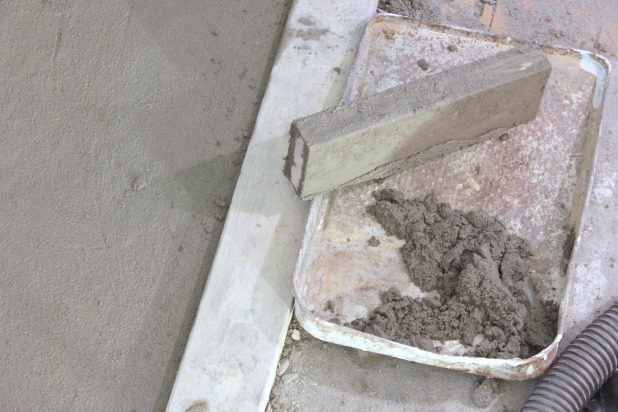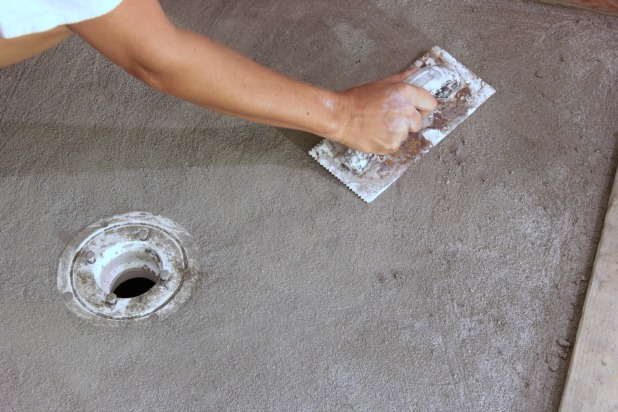Hey guys! We actually just got back from 10 days away, up to Maine visiting family and completely unwinding without cell or internet for a few of those days. Sorry for the crickets in the comments and on social media. Speaking of crickets, we didn’t really see much wildlife on our vacation (that transition works, right?), which is a bummer because I was really hoping to see a moose because I haven’t for many years and everyone has been talking about seeing a bunch of them this year.
We didn’t even catch any fish on our fishing trips. Well, Joel did catch something that my brother declared “the largest minnow I’ve ever seen”. But I don’t think that really counts. But check out how beautiful it was, the entire lake was like glass … maybe the fish could see us coming. 🙂

Now that we’re back I’m geared up to jump right back into things because our tile is coming, the bathroom window is ready and I’m supposed to be making a vanity. I want to kick things in high gear to get this room in working order already. We’ll see how the project and blog balance goes. And we’ll be patient with each other along the way. K? 🙂
So in addition to the DIY shower pan I’ve been working on we’re pretending to be plumbers around here. And by “we” I totally mean “Joel”. Determined to not let the lack of responsiveness from an actual plumber derail our progress, Joel jumped right in and took over. I am an hesitant active assistant … when he needs one … but I have plenty to keep me busy when he’s maneuvering around the crawl space, and when I don’t, I do my best to look busy so I don’t get roped into any of that mess. 😉
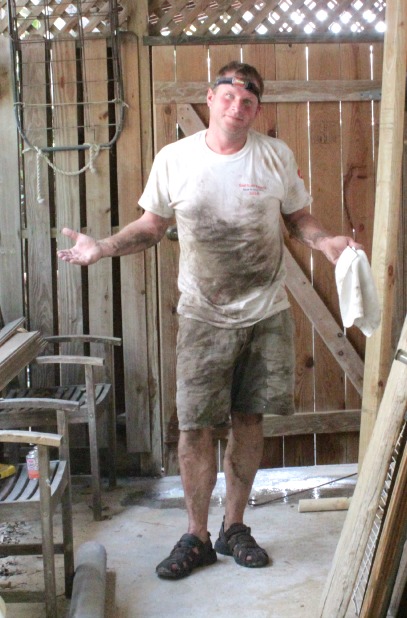
As an added bonus he often forgets he has the headlamp on so I am quick to make fun. I know. I’m awesome.
But seriously, I am so impressed. He is calculated, he takes the time to research and has spent more time in the plumbing aisle in HD than is normal for any one lifetime. So much so that every time we go back the workers are all “Hey, you’re back!” and we’re all “You know it!”. It doesn’t hurt that one of the managers in our local store is a plumber with 20+ years of experience. We’ve picked his brain on every aspect of this project. And have gotten a crash course in some key beginner plumbing tips that everyone should seriously know.
As an aside, just to prove that we tend to just hang out at HD, I even fit in a little workout on a recent trip.
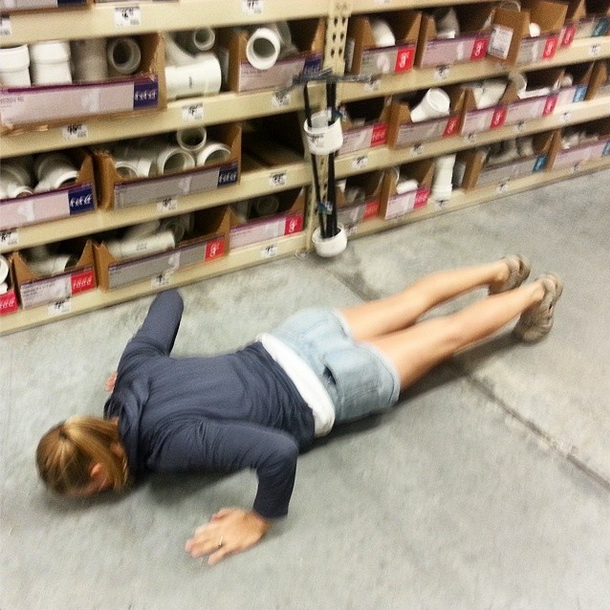
Ha, I was doing a little push up challenge with a few workout buddies where we have to do 10 push ups whenever we get a text … it was only a matter of time before I was caught in that plumbing aisle. 🙂
And now for the tips, in no particular order, because they will all seriously change your world if you ever want to tackle a little plumbing project.
1 – PVC and CPVC are two different materials entirely. Find out what you have and be sure! More tips on that here.
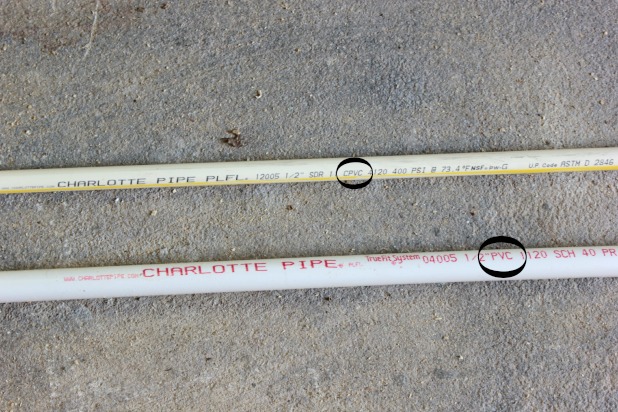
2 – CPVC is better for hot water. Something to keep in mind if you’re ever working with your water lines. It does create a little extra thinking but running CPVC for hot water and PVC for cold water is how the professionals do it. #JustAskJoel 😉
3- PVC measures diameter from the inside of the pipe and CPVC measures from the outside of the pipe. This tripped us up a bit before we got this tip. Because 1/2″ PVC pipes look like 3/4″ pipes, but it’s because the 1/2″ measurement is taken from the actual opening of the pipe.
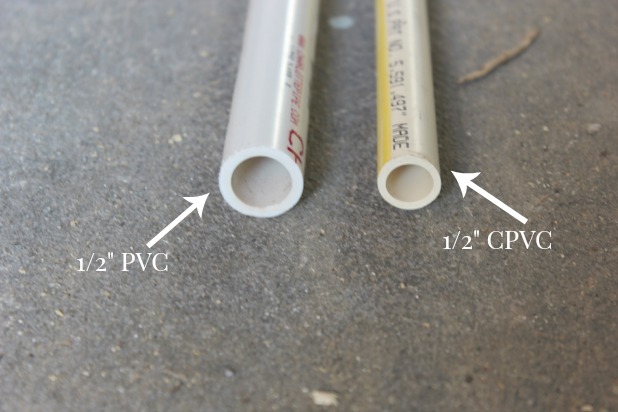
4 – These cutters exist, they work on both PVC and CPVC, get them. In Joel’s words “game changer”. Let’s just say trying to cut that stuff with a hack saw in the confines of the crawl space is not fun or easy, at all.
5 – So not only do you have to select between PVC and CPVC, but when you get into all of the PVC you’ll notice there seem to be two of everything. Good. Ness. Why are there two of the exact same thing? Ah ha. They are not the exact same thing. On the packaging you’ll see it’s either DWV or Schedule 40. Super clear now right?! Um, no. This is huge. DWV PVC can only be used for drains, waste or vents! They are not meant for the pressurized running water lines … that is what Schedule 40 is for. And I’m pretty sure that was our demise in that old bathroom in Maryland, trying to use (the cheaper option) DWV PVC for the water lines.
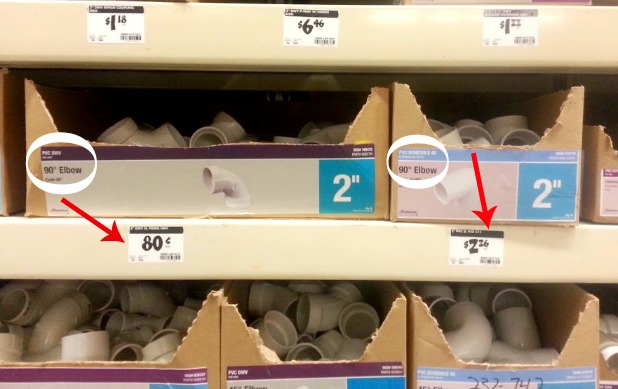
6 – Now, not only do you have to be clear on what kind of pipe you are using, you have to use the right glue for that kind of pipe. The glue labels are very clear what they will work for, but if you don’t know to look you might just grab the wrong one. Don’t make that mistake. That would be insanely frustrating … I would imagine. More on that in this post about how to cap a water pipe.
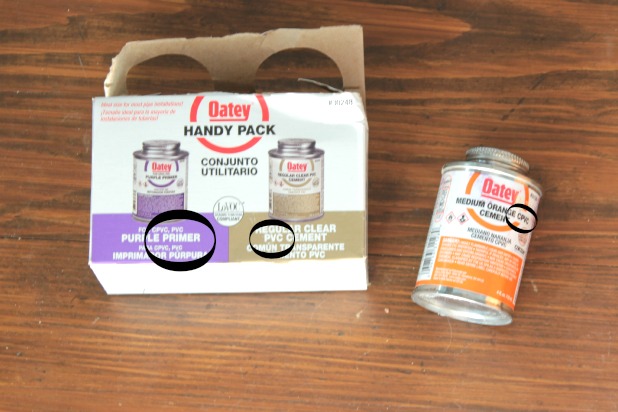
7 – Always use a primer (or acetone) before gluing, inspectors may actually look for the purple color of the primer during an inspection so don’t skip this step, even though it seems weird to have to prime plastic.
8 – When in doubt, add a shut off valve. We’ve had to shut off the water to our entire house multiple times in this process because we either didn’t have a shut off valve close to where we needed to work or they were non-functional. I may be on record saying “Too bad the water is shut off, I really wanted to wash the dishes … said me never.” But after a grimy DIY day sometimes all you can really think about is a shower … and then you have to wait an hour for your newly glued pipes to dry. Shut off valves seem very luxurious to us right now. Add them. We like these.
9- Definitely check your local codes but here are some guidelines we got from a professional plumber.
- Shower drains have to be 2″ diameter all the way to main line
- Toilet drains can be 3″ or 4″, but why take your chances, we’re going 4″
- Tub and sink drains can be 1 1/2″ under them but should be 2″ back to the main
- For sinks, basically run the 2″ line to the wall and when you transition the pipe to run up the wall convert it to 1 1/2″.
- All toilets need something called a clean out (picture worst case scenario and that will explain that) as well as a vent pipe run up the exterior of your house. If you have two toilets near each other they can have the same clean out and vent.
10 – I know it may seem that we are underestimating the work of trained plumbing professionals, but we’re really not. Have the number of a reliable plumber (one who will show up on nights, weekends, even Christmas morning) handy. We didn’t have any luck here in Key West so I actually called a plumber we’ve used regularly in Maryland. He answers all of our questions and even let us send him a sketch of our new layout so he could itemize exactly what we need to do. It’s actually one of my biggest tips when it comes to becoming a DIYer, rely on the professionals whenever necessary. Their inside knowledge is invaluable … I always ask “Is there anything I should know that I’m probably not thinking of?” Because there’s always something.
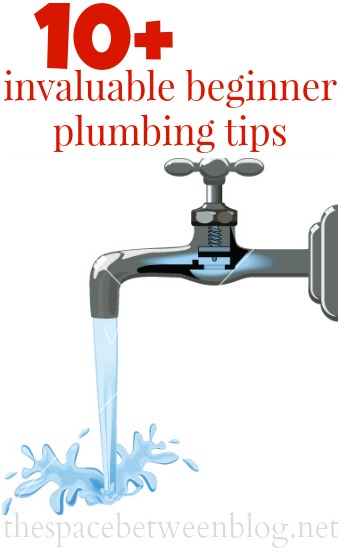
Have you ever tackled your own plumbing? Or learned a new DIY skill out of necessity? Or just think we’re crazy? That’s ok, too. 🙂

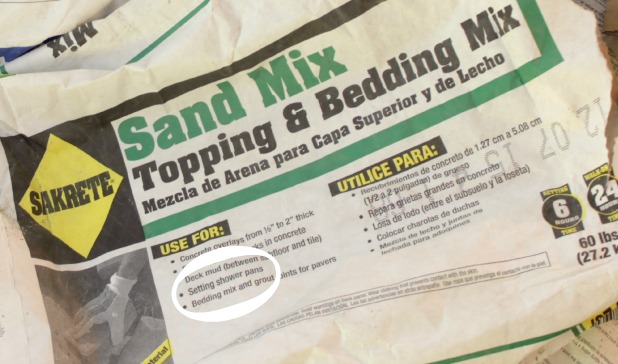
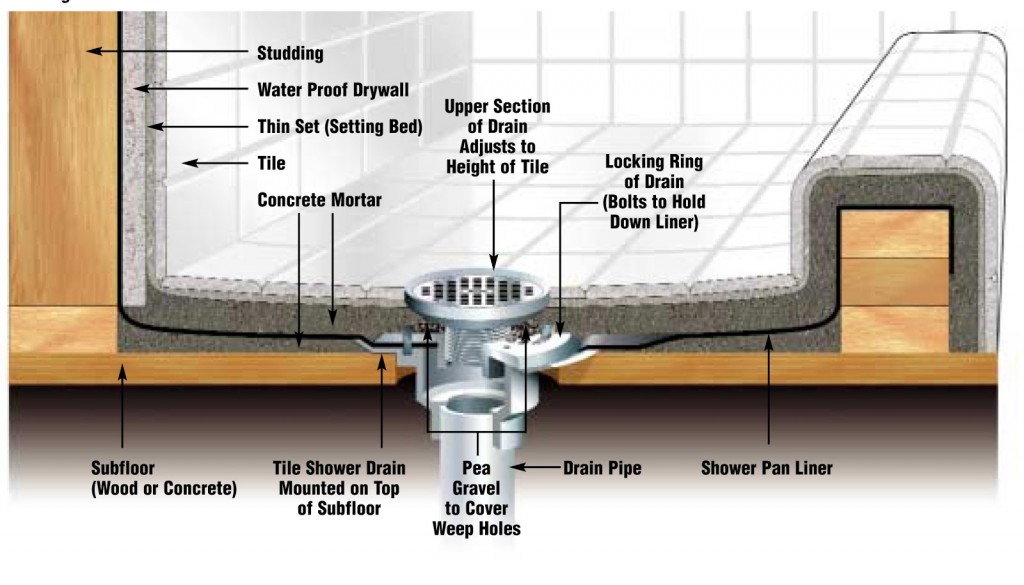 The purpose of the slope in a shower pan is to encourage all water toward the drain. Under the tile and thin set is a sloped mortar base that creates the slope for you to lay your tile. Under that slope is the PVC liner which is on top of your preslope. Seriously, if you’ve got water getting under all that tile and cement and PVC lining you’ve got bigger issues than a little preslope. 🙂
The purpose of the slope in a shower pan is to encourage all water toward the drain. Under the tile and thin set is a sloped mortar base that creates the slope for you to lay your tile. Under that slope is the PVC liner which is on top of your preslope. Seriously, if you’ve got water getting under all that tile and cement and PVC lining you’ve got bigger issues than a little preslope. 🙂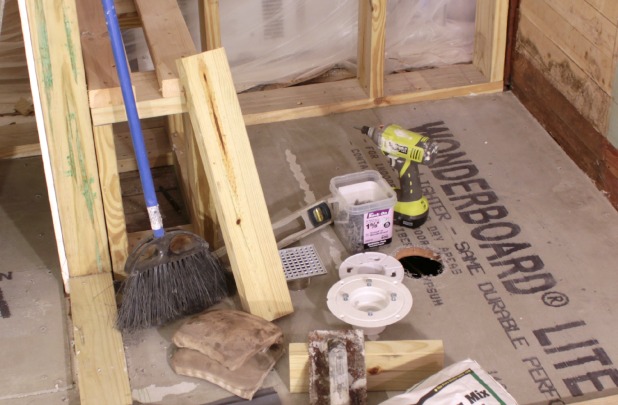
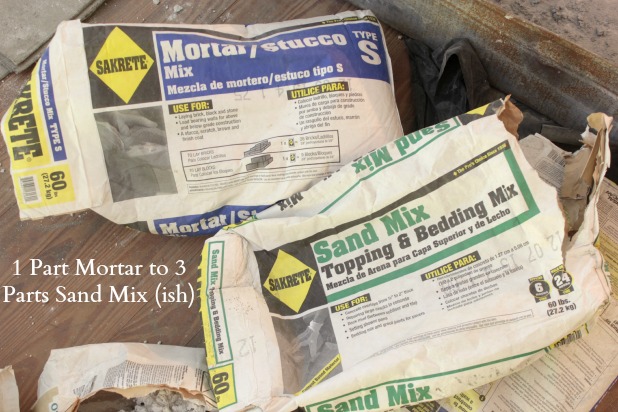 The plumber I consulted with over 20 years experience said it’s like mixing cake ingredients without a recipe. Knowing my skilz in the kitchen I knew I was doomed. But, it worked out. I liked using this rake thing to mix, so much easier than a shovel because it didn’t try to move all of the heavy mixture, but I would make sure to scoop up any dry mix from the bottom of the mix with a regular spade shovel, too.
The plumber I consulted with over 20 years experience said it’s like mixing cake ingredients without a recipe. Knowing my skilz in the kitchen I knew I was doomed. But, it worked out. I liked using this rake thing to mix, so much easier than a shovel because it didn’t try to move all of the heavy mixture, but I would make sure to scoop up any dry mix from the bottom of the mix with a regular spade shovel, too.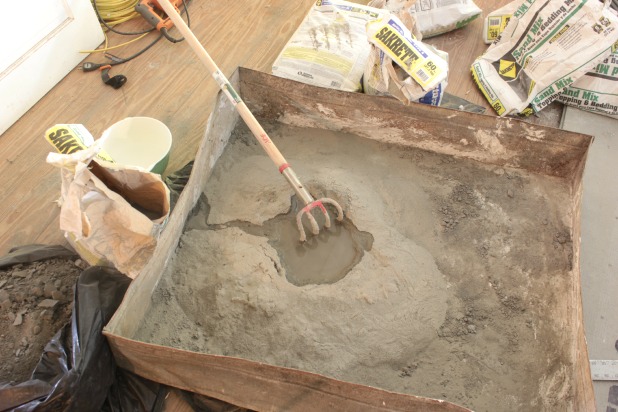

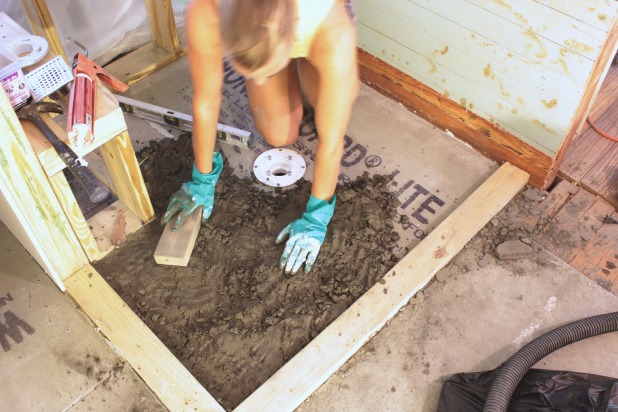
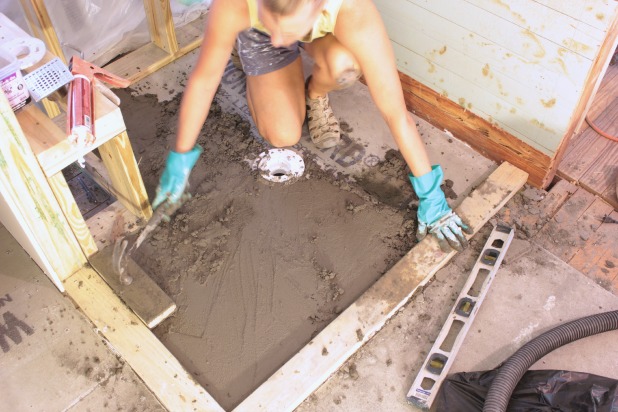
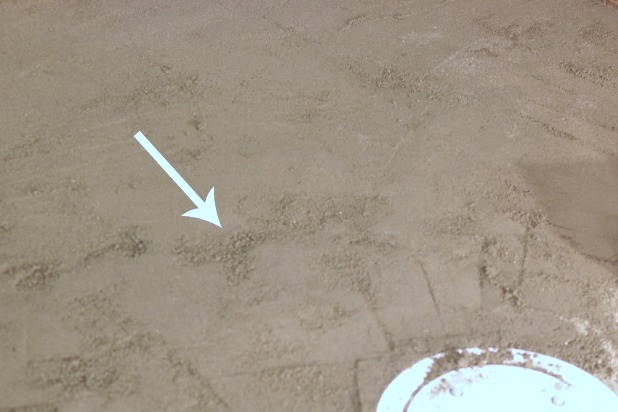
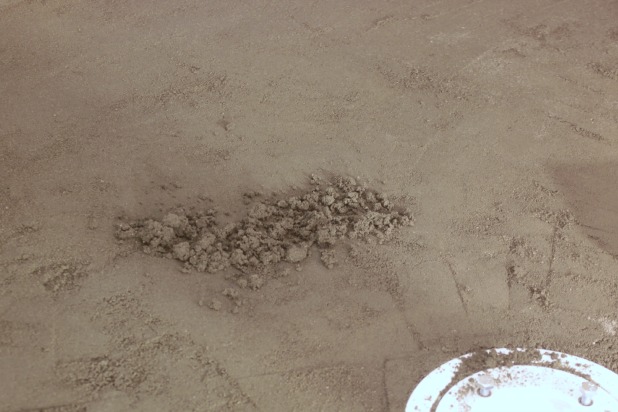
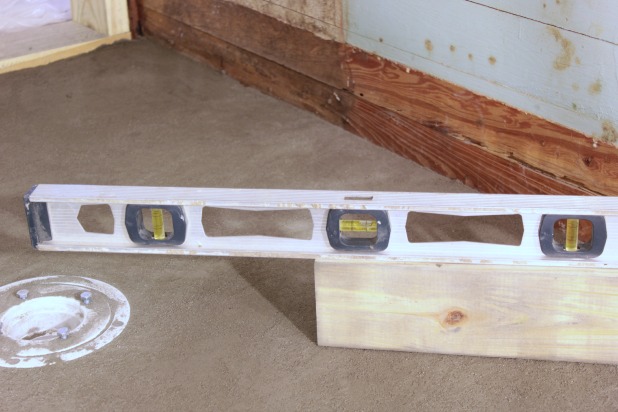
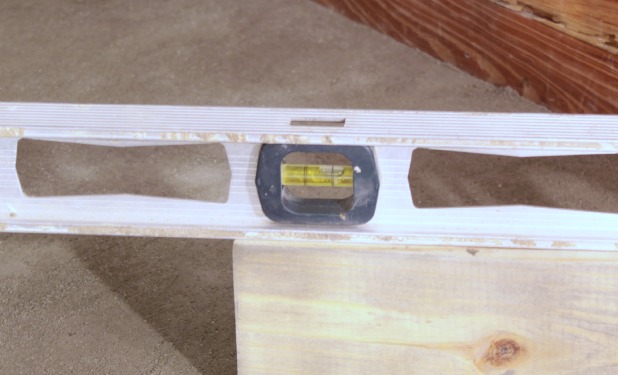
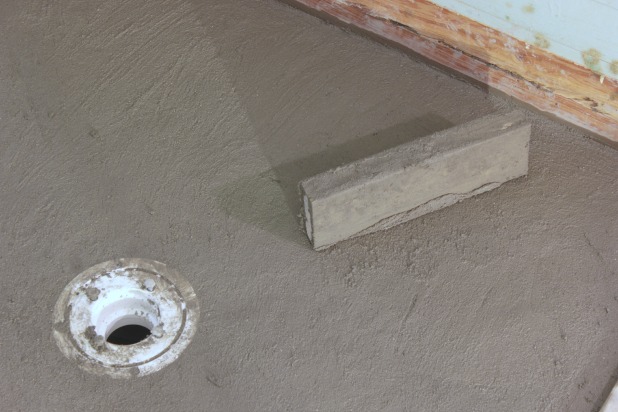 And then dumping the extra bits here.
And then dumping the extra bits here.